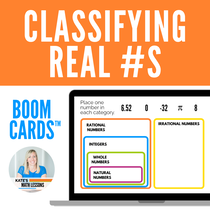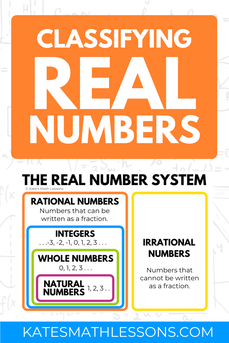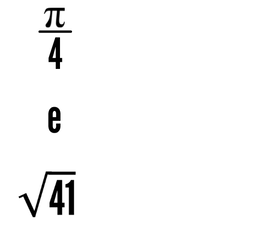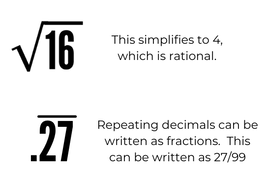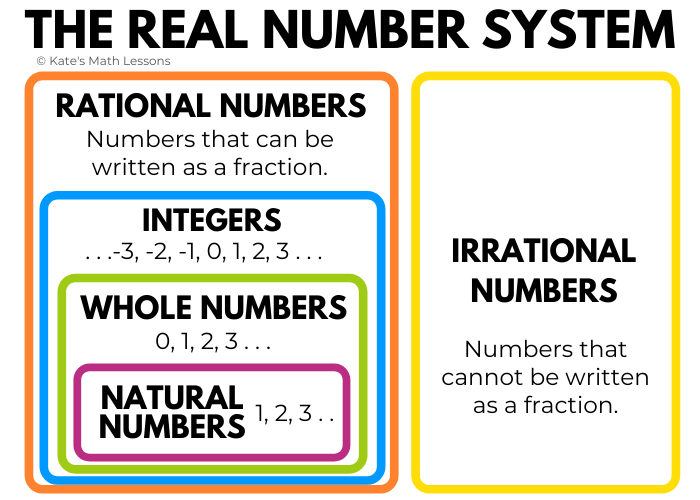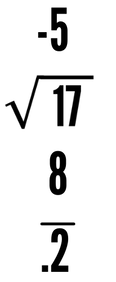|
Accompanying Resource:
Classifying Real Numbers Boom Cards |
Please note that this lesson includes irrational numbers. If you're looking for a simpler lesson, make sure to check out my Classifying Rational Numbers lesson that includes whole numbers, integers, and rational numbers.
Types of Numbers
|
Did you know that numbers haven't been around forever? Way back when, people didn't have words or symbols for numbers as simple as 1, 2, 3. . . Before numbers and their symbols were invented, people used sticks and made tally marks on stones as ways to keep track of things. Thankfully, a number system developed over time so we no longer need to use sticks or hold up fingers to count! We now have names and symbols that we use to represent numbers. (Want to see some of the earlier symbols that were used? Check out this article on the history of the number system.)
|
The number system that we use today has many different types of numbers. In this lesson, we'll look at 6 types: natural numbers, whole numbers, integers, rational numbers, irrational numbers, and real numbers. We'll start with the simplest set of numbers, the natural numbers.
Natural Numbers (Counting Numbers)
1, 2, 3 . . . .
Natural numbers start at 1 and go up from there. They're also sometimes referred to as counting numbers because we start at 1 when we learn to count. The natural numbers do not include zero, negative numbers, decimals or fractions. These are likely the first type of numbers that you learned about as a small child.
Examples of Natural Numbers:
6
18
305
NOT Natural Numbers:
0
-7
24.6
Natural numbers start at 1 and go up from there. They're also sometimes referred to as counting numbers because we start at 1 when we learn to count. The natural numbers do not include zero, negative numbers, decimals or fractions. These are likely the first type of numbers that you learned about as a small child.
Examples of Natural Numbers:
6
18
305
NOT Natural Numbers:
0
-7
24.6
Whole Numbers
0, 1, 2, 3 . . .
The whole numbers start at zero and count up. So similar to the natural numbers, with the addition of the number 0. Whole numbers do not include negative numbers, fractions, or decimals.
Examples of Whole Numbers:
5
23
167
14
NOT Whole Numbers:
8.9
-2
3/5
Bonus Note: Did you know people had a really hard time accepting 0 as a number? They used to think it was crazy to have a number represent "nothing." I hope you're glad it was invented, because we wouldn't have computers without the number 0! Check out this history of the number zero to learn more interesting facts about 0 (did you know some thought it was evil?).
The whole numbers start at zero and count up. So similar to the natural numbers, with the addition of the number 0. Whole numbers do not include negative numbers, fractions, or decimals.
Examples of Whole Numbers:
5
23
167
14
NOT Whole Numbers:
8.9
-2
3/5
Bonus Note: Did you know people had a really hard time accepting 0 as a number? They used to think it was crazy to have a number represent "nothing." I hope you're glad it was invented, because we wouldn't have computers without the number 0! Check out this history of the number zero to learn more interesting facts about 0 (did you know some thought it was evil?).
Integers
. . . -3, -2, -1, 0, 1, 2, 3 . . .
This set of numbers is similar to the whole numbers, but also includes negative numbers. Integers do not include fractions or decimals. All of the whole numbers are also integers.
Examples of Integers:
8
-34
721
-5
NOT Integers:
6.2
-7/8
This set of numbers is similar to the whole numbers, but also includes negative numbers. Integers do not include fractions or decimals. All of the whole numbers are also integers.
Examples of Integers:
8
-34
721
-5
NOT Integers:
6.2
-7/8
Rational Numbers
Numbers that can be written as a fraction.
Any number that can be expressed as a fraction is considered to be a rational number. I would list them out for you, but that's impossible because there are so many! All of the integers are also rational numbers because you can rewrite any of them as a fraction using a 1 in the denominator (for example, 5 can be rewritten as the fraction 5/1). Rational numbers also include terminating decimals (decimals that stop at some point), repeating decimals (like .2323. . . ), and numbers that are already written as fractions.
A more technical definition of a rational number will say that it's a ratio of two integers. When a rational number is written as a fraction, the numerator and denominator will both be integers (you can write the fraction without decimals in the top or bottom of the fraction).
Examples of Rational Numbers:
13.25
-7 (This can be written as the fraction -7/1)
2/5
.4444 . . . . (This can be written as the fraction 4/9)
NOT Rational Numbers:
A decimal that goes on forever without ending or repeating is not rational. Here are two examples:
Any number that can be expressed as a fraction is considered to be a rational number. I would list them out for you, but that's impossible because there are so many! All of the integers are also rational numbers because you can rewrite any of them as a fraction using a 1 in the denominator (for example, 5 can be rewritten as the fraction 5/1). Rational numbers also include terminating decimals (decimals that stop at some point), repeating decimals (like .2323. . . ), and numbers that are already written as fractions.
A more technical definition of a rational number will say that it's a ratio of two integers. When a rational number is written as a fraction, the numerator and denominator will both be integers (you can write the fraction without decimals in the top or bottom of the fraction).
Examples of Rational Numbers:
13.25
-7 (This can be written as the fraction -7/1)
2/5
.4444 . . . . (This can be written as the fraction 4/9)
NOT Rational Numbers:
A decimal that goes on forever without ending or repeating is not rational. Here are two examples:
Irrational Numbers
Numbers that cannot be written as a simple fraction.
In other words, not rational. Irrational numbers cannot be written as a ratio of two integers. Decimals that do not end or repeat are irrational numbers. Some irrational numbers are used so often that they have their own name and symbol like pi (3.14159265. . . ) and Euler's number e (2.71828. . . ).
Many square roots, cube roots, etc. are also irrational numbers. For example, the square root of 41 is approximately 6.40312423. . . It is a decimal that does not end or repeat and is an irrational number.
Note of caution: Not all square roots are irrational! For example, the square root of 64 is 8 (which is rational). You may need to simplify an expression first in order to determine the type of number.
Examples of Irrational Numbers:
In other words, not rational. Irrational numbers cannot be written as a ratio of two integers. Decimals that do not end or repeat are irrational numbers. Some irrational numbers are used so often that they have their own name and symbol like pi (3.14159265. . . ) and Euler's number e (2.71828. . . ).
Many square roots, cube roots, etc. are also irrational numbers. For example, the square root of 41 is approximately 6.40312423. . . It is a decimal that does not end or repeat and is an irrational number.
Note of caution: Not all square roots are irrational! For example, the square root of 64 is 8 (which is rational). You may need to simplify an expression first in order to determine the type of number.
Examples of Irrational Numbers:
NOT Irrational Numbers:
Real Numbers
The set of all rational and irrational numbers.
All of the numbers that we've looked at in this lesson are called real numbers. So all of the natural numbers, whole numbers, integers, rational numbers and irrational numbers are all real numbers.
So are all numbers real numbers? Nope. But most of the numbers you're familiar with are real numbers.
Remember that people used to think the idea of 0 as a number was crazy? That's probably how you'll feel when I tell you there are numbers that are called imaginary numbers. The name imaginary is pretty unfortunate since it gives people the impression that they're just pretend numbers, but they do exist and are useful in things like electrical engineering and quantum physics (it's pretty complex stuff so you may not learn about them until an upper level math course). Check out this Imaginary Numbers lesson if you want to learn more!
All of the numbers that we've looked at in this lesson are called real numbers. So all of the natural numbers, whole numbers, integers, rational numbers and irrational numbers are all real numbers.
So are all numbers real numbers? Nope. But most of the numbers you're familiar with are real numbers.
Remember that people used to think the idea of 0 as a number was crazy? That's probably how you'll feel when I tell you there are numbers that are called imaginary numbers. The name imaginary is pretty unfortunate since it gives people the impression that they're just pretend numbers, but they do exist and are useful in things like electrical engineering and quantum physics (it's pretty complex stuff so you may not learn about them until an upper level math course). Check out this Imaginary Numbers lesson if you want to learn more!
Using a Graphic Organizer to Classify Real Numbers
|
Here's a diagram to help you understand how all of the different types of numbers are related to each other. The natural numbers are inside of the whole numbers because all natural numbers are also whole numbers. Whole numbers are inside of the integers because all whole numbers are also integers. Integers are inside of the rational numbers because all integers can be written as a fraction.
|
Notice that the rational numbers and irrational numbers are in completely separate boxes. A real number is going to be either rational or irrational, never both. All of these types of numbers make up what we call the Real Number System, it's the set of all rational and irrational numbers.
Let's say you have to classify the following numbers:
Let's say you have to classify the following numbers:
When I classify numbers, I start on the rational side in the innermost section and work my way out.
Let's look at -5 first. Is it a natural number? No, natural numbers don't include negative numbers. Is -5 a whole number? No, whole numbers don't include negative numbers either. Is it an integer? Yes, integers include -1, -2, -3, etc. so -5 is an integer. -5 is also a rational number since it can be written as the fraction -5/1, but the term integer is more specific.
Next, let's look at the square root of 17. 17 is not a perfect square, so this does not simplify to a rational number. The square root of 17 is approximately 4.123105. . . Decimals that do not end or repeat cannot be written as fractions, which means the square root of 17 is an irrational number.
What about 8? If we start in the innermost section, we can see that 8 is a natural number (or counting number). This means that 8 is also a whole number, and an integer, and a rational number.
Last, we'll look at the .2222. . . (the little bar over the 2 means it repeats). Decimals are not included in natural numbers, whole numbers, or integers. But repeating decimals can be written as a fraction (in this case it can be written as 2/9), which means .2222. . . is a rational number.
